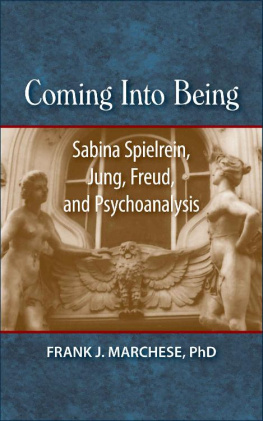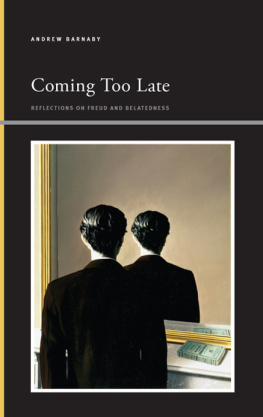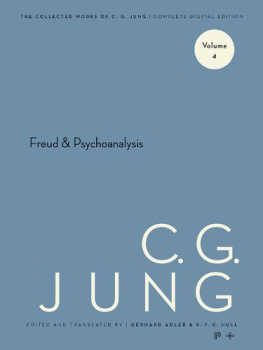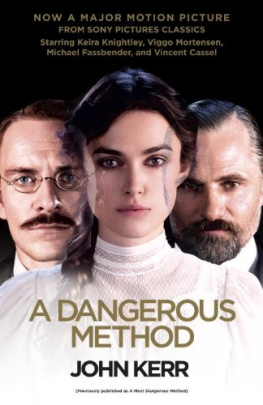Frank J. Marchese PhD - Coming Into Being: Sabina Spielrein, Jung, Freud, and Psychoanalysis
Here you can read online Frank J. Marchese PhD - Coming Into Being: Sabina Spielrein, Jung, Freud, and Psychoanalysis full text of the book (entire story) in english for free. Download pdf and epub, get meaning, cover and reviews about this ebook. year: 2015, publisher: Frank J. Marchese, PhD, genre: Science. Description of the work, (preface) as well as reviews are available. Best literature library LitArk.com created for fans of good reading and offers a wide selection of genres:
Romance novel
Science fiction
Adventure
Detective
Science
History
Home and family
Prose
Art
Politics
Computer
Non-fiction
Religion
Business
Children
Humor
Choose a favorite category and find really read worthwhile books. Enjoy immersion in the world of imagination, feel the emotions of the characters or learn something new for yourself, make an fascinating discovery.
- Book:Coming Into Being: Sabina Spielrein, Jung, Freud, and Psychoanalysis
- Author:
- Publisher:Frank J. Marchese, PhD
- Genre:
- Year:2015
- Rating:5 / 5
- Favourites:Add to favourites
- Your mark:
- 100
- 1
- 2
- 3
- 4
- 5
Coming Into Being: Sabina Spielrein, Jung, Freud, and Psychoanalysis: summary, description and annotation
We offer to read an annotation, description, summary or preface (depends on what the author of the book "Coming Into Being: Sabina Spielrein, Jung, Freud, and Psychoanalysis" wrote himself). If you haven't found the necessary information about the book — write in the comments, we will try to find it.
Coming Into Being: Sabina Spielrein, Jung, Freud, and Psychoanalysis — read online for free the complete book (whole text) full work
Below is the text of the book, divided by pages. System saving the place of the last page read, allows you to conveniently read the book "Coming Into Being: Sabina Spielrein, Jung, Freud, and Psychoanalysis" online for free, without having to search again every time where you left off. Put a bookmark, and you can go to the page where you finished reading at any time.
Font size:
Interval:
Bookmark:
.
ComingInto Being

Sabina Spielrein,
Jung,Freud, and Psychoanalysis
Frank J. Marchese, P h D
.
Published byFrank J. Marchese, PhD
Toronto, Canada
Frank J.Marchese, PhD
All rightsreserved
Published 2015
Front coverphotograph
by Robin Mason
Prague, 2007
Authorsphotograph
by Robin Mason
Paris, 2012
ISBN:978-0-9687967-3-3
.
To Bluejay

per sempre
.
Contents
Withoutthe help I received from many quarters, this book would have not beencompleted. I am grateful for this assistance and wish to acknowledge thefollowing persons: Nicole Hilton for her patience and skills as an editorduring the early stages of this project and R. Andrew Paskauskas, editor of TheComplete Correspondence of Sigmund Freud and Ernest Jones, 19081939(1993), for providing astute and helpful comments on various drafts of themanuscript. Matthew Kudelka, who edited an early version of the manuscript. NatashaKisenkov for making a number of useful suggestions and Anna Kiseleva, whogenerously provided materials pertaining to Spielreins life and psychoanalyticwork in Russia. Dr. Michel Silberfeld for his kind support and encouragement.Samita Sarkar for her thorough editing of more recent portions of themanuscript, which brought the book closer to completion. Robin Alter forproviding valuable information about copy editing and publication venues.Catharine Chen for her superb work on the index of the print edition. And DidiPollock, whose excellent editorial work on the final draft and advice on designand layout were of considerable help to me in finishing what I started threeyears ago.
And finally, I owe a debt of gratitude to my wife,Robin Mason, who from December of 2011 listened with interest and patience tomy enthusiastic and interminable chatter over my newly discovered interest inSabina Spielrein. Her commentaries, encouragement, and support over these lastfew years were of immeasurable importance in sustaining my optimism and energythroughout.
For too long, the key role played by Sabina Spielreinin the early years of psychoanalysis has been overlooked. I hope that this bookcontributes to the well-deserved renewal of interest in her achievements andher legacy.
Lastly, I bear full responsibility for the content ofthis book.
Frank J. Marchese
December 31, 2015
Toronto, Canada
Where love reigns, the ego, the ominous despot, dies.
Sabina Spielrein
This book concerns theRussian psychiatrist and psychoanalyst, Sabina Spielrein, her relationship toCarl Jung and Sigmund Freud, and her contribution to psychoanalysis in itsearly history and development. Spielrein began as a patient of Carl Jung andbecame a successful medical student, a psychiatrist and psychoanalyst in herown right and a colleague of Jung and Freud. Yet it has been rightfullysuggested that Spielrein was never accorded the recognition she deserved forher influence on the theory and practice of psychoanalysis (Covington, 2003a).Although Freud and Jung are regarded as pioneers of modern psychology, as onehistorian of psychoanalysis reminded us, in the written history ofpsychoanalysis we look in vain for Sabina Spielrein (Richebcher, 2003, p. 246).As a recent biographical commentary put it, she seems to have vanished fromthe psychoanalytic literature (Launer, 2011, p. 9).
Vanished? Ironic, in light of what the eminent childpsychologist and psychoanalyst, Bruno Bettelheim (1983), noted in regard toSpielrein. He said she was one of the great pioneers of psychoanalysis(p. 44). Two prominent historians of psychoanalysis, Appignanesi andForrester (2000), concur with Bettelheims viewpoint. They remark thatSpielrein was the first woman analyst to have a significant theoretical impacton psychoanalysis (p. 204). And yet, for most of the twentieth century,the main record of her existence consisted of four footnotes in Freudsessays (Launer, 2011, p. 9).
Recently, however, there has been a rekindling ofinterest in Spielrein. In 2011, Canadian director David Cronenberg released afilm entitled A Dangerous Method, about her relationship with Jung andFreud. There has also been renewed interest among academic writers such asCovington and Wharton (2003) and Allain-Dupr (2004).
In writing this book, my aim has been to bring certainaspects of Spielreins life into sharper relief. The book offers a review andanalysis of the historical portrayal of Spielreins influence on Freud andJungs thinking, and broadens the scope of Spielreins place in the early yearsof the development of psychoanalysis. By examining her theoretical insights andher contributions to important concepts such as Freuds death instinct,transference/countertransference,the book will help to restore Spielreins deserved place among thoseearly pioneers in psychoanalysis. Furthermore, this book explores the methodthat these three principal figures developed and utilized in the early days of analytictherapy as a treatment technique for mental illness. It reveals how Spielrein,Jung, and Freud were profoundly affectedindividually, personally, andcollectivelyby the very method for madness, or talking cure, they employedwith those afflicted with mental problems.
It is necessary to shed some light on the beginnings ofpsychoanalysis, especially in regard to Spielreins overlooked contributions tothe early years of its development. Just as it was with Josef Breuer(18421925), whose role was minimized by Freud over the years, so it was withSpielrein, whose contributions were ignored outright by the psychoanalyticestablishment. Freud refashioned the history of psychoanalysis to suit hispurposes, with his Dream of Undying Fame. As Breger (2009) comments, Freudplaced himself at the forefront of developments in psychoanalysis while failingto give due credit to others. It was not until 1920, in his Beyond thePleasure Principle, that Freud openly acknowledged the importance ofSpielreins efforts. In 1930, in his Civilization and its Discontents,Freud made a further attempt at acknowledgement. There he tried to understandwhy he had not been receptive to her ideas years earlier (Cremerius, 2003). Hisadmissions came eight and eighteen years, respectively, after the publicationof her seminal contribution to psychoanalytic theory, Destruction as the Causeof Coming into Being of 1912 (Spielrein, 1912/1994).
This book is an exploration of the relationships thatdeveloped between Spielrein, Jung, and Freud. In concentrating on theintricacies of these relationships, we gain a glimpse of why Spielrein was notgiven due credit at the time she presented her key ideas. It has been suggestedthat Freud and Jung rejected Sabina Spielreins theory in its entirety(Launer, 2011, p. 10). For example, she postulated an inevitable conflictbetween two drives: on the one hand, the drive to self-preservation, whichprotected the individuals personal survival; and the species-reproductiondrive on the other, which pressed for continuance of the species throughprocreative acts. As the aim of the species-preservation drive asserted itself,it came into conflict with the self-preservation drive; for as the formerpressed for expression through the act of procreation, the individual wasrequired to sacrifice his or her identity to bring about new life.
According to Spielrein, reproduction was bothdestructive and creative; it was destructive of the individuals identity butcreative for the continuance of the species. As Spielrein said of these twocompeting drives, No change can take place without destruction of the former[identity] condition (1912/1994, p. 174). While reproduction created anew generation, it also destroyed the original identity of both the maleand female. The interweaving of the idea of sacrifice, comprising both love anddeath (destruction), implied that nothing new can come into being withoutdestruction of the old order. The individual, she said, must strongly hungerfor this new creation in order to place its own destruction in creationsservice (Spielrein, 1912/1994, p. 156). In other words, reproductionpredominated over survival, since the singular aims of the individual did notalways harmonize with the collective aims of reproduction. As Spielreinsaid, We see that the collective desires living within us do not correspond topersonal desires (1912/1994, p. 162).
Font size:
Interval:
Bookmark:
Similar books «Coming Into Being: Sabina Spielrein, Jung, Freud, and Psychoanalysis»
Look at similar books to Coming Into Being: Sabina Spielrein, Jung, Freud, and Psychoanalysis. We have selected literature similar in name and meaning in the hope of providing readers with more options to find new, interesting, not yet read works.
Discussion, reviews of the book Coming Into Being: Sabina Spielrein, Jung, Freud, and Psychoanalysis and just readers' own opinions. Leave your comments, write what you think about the work, its meaning or the main characters. Specify what exactly you liked and what you didn't like, and why you think so.







